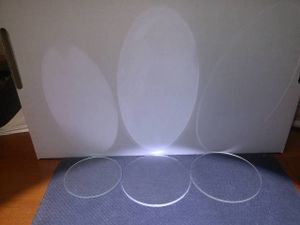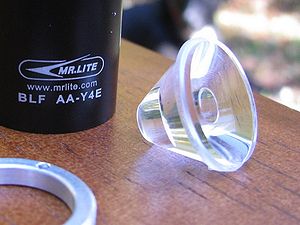Lenses: Difference between revisions
| (5 intermediate revisions by the same user not shown) | |||
| Line 9: | Line 9: | ||
'''Sapphire''' Another choice is a sapphire lens made of synthetic sapphire (not actually glass) which is stronger than tempered glass and very resistant to scratches. Due to it scratch resistance, sapphire is often used for watch crystals, but is also available as a flashlight lens. | '''Sapphire''' Another choice is a sapphire lens made of synthetic sapphire (not actually glass) which is stronger than tempered glass and very resistant to scratches. Due to it scratch resistance, sapphire is often used for watch crystals, but is also available as a flashlight lens. | ||
'''Anti-reflective coating''' For the same reason telescopes, binoculars, and camera lenses have coated lenses, better flashlights include a coating on the lens surface that allows more light through by preventing light from the emitter from reflecting off of the lens instead of going through it. A typical loss for uncoated glass is 4% as light enters the lens and another 4% as it passes through back into the air. However high-end coated lenses might only have a total loss of 1%. For | '''Anti-reflective coating''' For the same reason telescopes, binoculars, and camera lenses have coated lenses, better flashlights include a coating on the lens surface that allows more light through by preventing light from the emitter from reflecting off of the lens instead of going through it. A typical loss for uncoated glass is 4% as light enters the lens and another 4% as it passes through back into the air. However high-end coated lenses might only have a total loss of 1%. For LEDs this is like getting an extra bin of brightness from a light. Because an AR coating improves transmission of only a narrow wavelength of light, multiple layers of different thicknesses are used to get improved transmission of more wavelengths of light. Coated lenses are available from [http://www.flashlightlens.com/index.php?app=ecom&ns=prodshow&ref=ucl_lens FlashlightLens.com], [http://www.kaidomain.com/Search/SearchResult.coated%20lens KaiDomain], and [http://intl-outdoor.com/components-glass-lens-c-57_95.html International Outdoor] in the most common sizes, including 28mm for many [[P60]] hosts.<ref>[http://budgetlightforum.com/node/1026 Where do you get good replacement lenses for P60 hosts?] BLF Thread</ref> | ||
==Aspheric lens== | ==Aspheric lens== | ||
| Line 17: | Line 17: | ||
==TIR optic== | ==TIR optic== | ||
[[File:Tir-optic.jpg|thumb|300px|Plastic TIR optic gives a very tight hotspot]]Also called a "collimating lens", a TIR optic takes advantage of "total internal reflection" where light that strikes a surface at a shallow angle will bounce off the surface and continue through the material instead of scattering. The optic collimates the light and sends a concentrated beam of light out in the same direction, giving a tight hotspot with greater throw. With a TIR optic in place, a reflector is not needed. A typical TIR lens looks like a cone with a hole where the point should be extending about halfway through the lens. This hole fits over the LED and any rays that strike the flat bottom of the hole will go straight out the front, giving a small hotspot. | [[File:Tir-optic.jpg|thumb|300px|Plastic TIR optic gives a very tight hotspot]]Also called a "collimating lens", a TIR optic takes advantage of "total internal reflection" where light that strikes a surface at a shallow angle will bounce off the surface and continue through the material instead of scattering. The optic collimates the light and sends a concentrated beam of light out in the same direction, giving a tight hotspot with greater throw. With a TIR optic in place, a reflector is not needed. A typical TIR lens looks like a cone with a hole where the point should be extending about halfway through the lens. This hole fits over the LED and any rays that strike the flat bottom of the hole will go straight out the front, giving a small hotspot. TIR optics are often used in lights with 3 or 4 LED's. Carlco brand triples are very popular with modders for various LED's and viewing angles. | ||
==References== | |||
<references> | |||
Latest revision as of 15:01, 3 June 2016
Flat lens
A flat lens is sometimes called a "window" and although it does not have a lens shape, most people still call it a lens.
Plastic Less expensive lights usually have a flat plastic lens over the reflector and bulb (or LED). Plastic lenses are more resilient than glass and can be useful if the light will get knocked around and take some abuse. However, plastic is easier to scratch and often not as clear as glass.

Glass Glass lenses are more common in better lights. Borosilicate glass like Pyrex has lower thermal expansion than regular glass and therefore is less likely to crack when the lens is exposed to higher temperatures, like from an incandescent light. Tempered glass is heated and cooled to introduce stresses in the glass that make it stronger than regular glass, but it can not be ground after tempering.
Sapphire Another choice is a sapphire lens made of synthetic sapphire (not actually glass) which is stronger than tempered glass and very resistant to scratches. Due to it scratch resistance, sapphire is often used for watch crystals, but is also available as a flashlight lens.
Anti-reflective coating For the same reason telescopes, binoculars, and camera lenses have coated lenses, better flashlights include a coating on the lens surface that allows more light through by preventing light from the emitter from reflecting off of the lens instead of going through it. A typical loss for uncoated glass is 4% as light enters the lens and another 4% as it passes through back into the air. However high-end coated lenses might only have a total loss of 1%. For LEDs this is like getting an extra bin of brightness from a light. Because an AR coating improves transmission of only a narrow wavelength of light, multiple layers of different thicknesses are used to get improved transmission of more wavelengths of light. Coated lenses are available from FlashlightLens.com, KaiDomain, and International Outdoor in the most common sizes, including 28mm for many P60 hosts.[1]
Aspheric lens
Instead of a flat lens, an aspheric lens can be used that will focus the light into a tighter beam. By moving the lens with respect to the emitter, a tight beam or wider flood can be obtained. Lights with a movable lens are called flood-to-throw lights. When properly focused for maximum throw, an image of the emitter is projected showing bonding wires and strips of the LED. Though frequently called aspheric, many times the lens involved has the traditional curvilinear shape and therefore isn't really aspheric.
TIR optic

Also called a "collimating lens", a TIR optic takes advantage of "total internal reflection" where light that strikes a surface at a shallow angle will bounce off the surface and continue through the material instead of scattering. The optic collimates the light and sends a concentrated beam of light out in the same direction, giving a tight hotspot with greater throw. With a TIR optic in place, a reflector is not needed. A typical TIR lens looks like a cone with a hole where the point should be extending about halfway through the lens. This hole fits over the LED and any rays that strike the flat bottom of the hole will go straight out the front, giving a small hotspot. TIR optics are often used in lights with 3 or 4 LED's. Carlco brand triples are very popular with modders for various LED's and viewing angles.
References
<references>